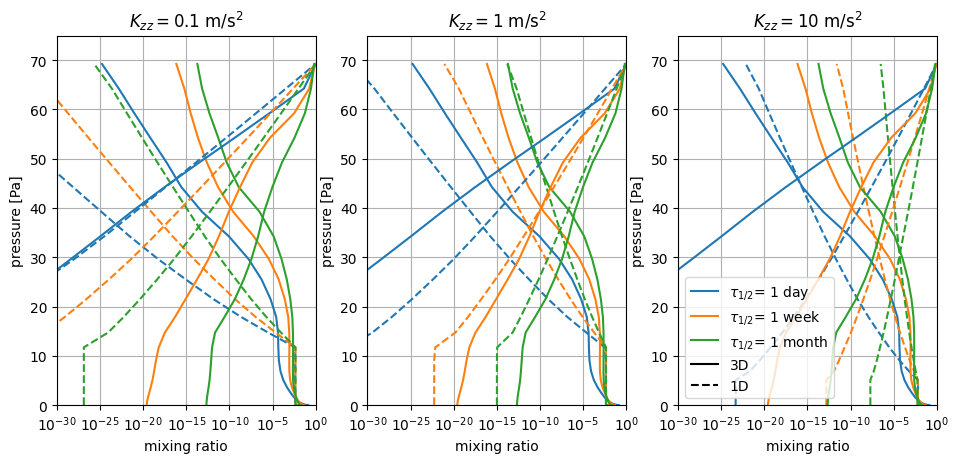Difference between revisions of "Radioactive tracers"
| Line 1: | Line 1: | ||
= Motivation = | = Motivation = | ||
| − | The Generic PCM has both a 3D and a 1D version. While the 3D self-consistently solves for dynamical mixing of advected quantities (like temperature or tracers), this process can only be parametrized in 1D. This is done by approximating dynamical mixing by a diffusive process, and tuning a value for the effective vertical diffusion, often referred to as the eddy mixing coefficient, | + | The Generic PCM has both a 3D and a 1D version. While the 3D self-consistently solves for dynamical mixing of advected quantities (like temperature or tracers), this process can only be parametrized in 1D. This is done by approximating dynamical mixing by a diffusive process, and tuning a value for the effective vertical diffusion, often referred to as the eddy mixing coefficient, <math>K_{zz}</math>. |
| − | Depending on the planetary setup, the value (or vertical profile) of | + | Depending on the planetary setup, the value (or vertical profile) of <math>K_{zz}</math> that can best reproduce 3D mixing varies. If you want to tune the vertical eddy mixing coefficient to one of your 3D cases, you can run a simulation with radioactively decreasing abstract tracers in both 1D and 3D and compare the vertical distribution of these tracers once a steady-state is reached. In 3D, this distribution is the result of a competition between dynamical mixing which tends to homogenize the atmosphere, and radioactive decay which destroys the tracers with increasing probability with time after their injection. Injection is done by the surface or the top of the atmosphere. Depending on the location of injection, half-life of the tracers, and atmosphere dynamics, the steady-state profile vary. |
= Use = | = Use = | ||
In order to use radioactive tracers, you simply need to add them to the traceur.def file, and define their half-life as well as injection flux at each location. This is done by setting the flags corresponding to these values in the modern version of the traceur.def. In the Generic PCM deftank, the file traceur.def.radioactive gives an illustration of it, which 6 different tracers, each having half life of 1 second, 1 minutes or 1 hour (normalized by the time of a Martian sol), injected by the surface or the top of the atmosphere. | In order to use radioactive tracers, you simply need to add them to the traceur.def file, and define their half-life as well as injection flux at each location. This is done by setting the flags corresponding to these values in the modern version of the traceur.def. In the Generic PCM deftank, the file traceur.def.radioactive gives an illustration of it, which 6 different tracers, each having half life of 1 second, 1 minutes or 1 hour (normalized by the time of a Martian sol), injected by the surface or the top of the atmosphere. | ||
| − | Below is an illustration of the steady-state distribution of these tracers in the early Mars atmosphere of the benchmark in 3D, and in 1D for three differrent values of | + | Below is an illustration of the steady-state distribution of these tracers in the early Mars atmosphere of the benchmark in 3D, and in 1D for three differrent values of <math>K_{zz}</math>. One sees that large <math>K_{zz}</math> overestimate vertical mixing and thus atmosphere homogenization, while low values underestimate it. |
[[File:Radioactive tracers.png|center|frame|Comparison of the vertical mixing between a 3D case and 3 1D simulations of early Mars atmosphere using different values of the eddy mixing coefficient.]] | [[File:Radioactive tracers.png|center|frame|Comparison of the vertical mixing between a 3D case and 3 1D simulations of early Mars atmosphere using different values of the eddy mixing coefficient.]] | ||
Revision as of 17:35, 14 April 2025
Motivation
The Generic PCM has both a 3D and a 1D version. While the 3D self-consistently solves for dynamical mixing of advected quantities (like temperature or tracers), this process can only be parametrized in 1D. This is done by approximating dynamical mixing by a diffusive process, and tuning a value for the effective vertical diffusion, often referred to as the eddy mixing coefficient, \(K_{zz}\).
Depending on the planetary setup, the value (or vertical profile) of \(K_{zz}\) that can best reproduce 3D mixing varies. If you want to tune the vertical eddy mixing coefficient to one of your 3D cases, you can run a simulation with radioactively decreasing abstract tracers in both 1D and 3D and compare the vertical distribution of these tracers once a steady-state is reached. In 3D, this distribution is the result of a competition between dynamical mixing which tends to homogenize the atmosphere, and radioactive decay which destroys the tracers with increasing probability with time after their injection. Injection is done by the surface or the top of the atmosphere. Depending on the location of injection, half-life of the tracers, and atmosphere dynamics, the steady-state profile vary.
Use
In order to use radioactive tracers, you simply need to add them to the traceur.def file, and define their half-life as well as injection flux at each location. This is done by setting the flags corresponding to these values in the modern version of the traceur.def. In the Generic PCM deftank, the file traceur.def.radioactive gives an illustration of it, which 6 different tracers, each having half life of 1 second, 1 minutes or 1 hour (normalized by the time of a Martian sol), injected by the surface or the top of the atmosphere.
Below is an illustration of the steady-state distribution of these tracers in the early Mars atmosphere of the benchmark in 3D, and in 1D for three differrent values of \(K_{zz}\). One sees that large \(K_{zz}\) overestimate vertical mixing and thus atmosphere homogenization, while low values underestimate it.
